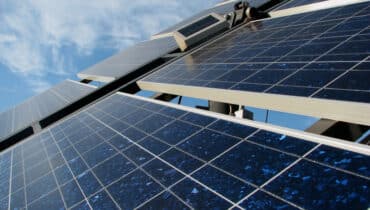Solar module racking, an often-overlooked component, serves as the structural framework for solar panels. This critical element optimizes panel orientation, ensuring efficient sunlight capture. Learn about its types, components, and how it contributes to maximizing energy production. Discover the backbone of successful solar installations.
As the world embraces renewable energy solutions, solar power has emerged as a pivotal player in the transition towards a sustainable future. Solar panels, also known as photovoltaic (PV) modules, are at the forefront of this revolution. However, while solar panels garner much of the attention, it’s equally important to understand the underlying infrastructure that supports them, including the concept of solar module racking.
Table of Contents
What Is Solar Module Racking?
Solar module racking, often simply referred to as “racking,” is a critical but often overlooked component in a solar power system. Racking is the structural framework that holds solar panels in place, allowing them to be securely mounted on various surfaces such as rooftops, ground installations, or tracking systems. The primary purpose of solar module racking is to maximize energy generation by optimizing the orientation and angle of the panels.
Types of Solar Module Racking
There are several types of solar module racking systems to accommodate various applications. Ground-mounted racking suits open land and large commercial installations, offering flexibility in panel positioning. Roof-mounted racking is designed for residential and commercial rooftops, integrating with the building structure.
Tracking racking systems use automation to follow the sun’s path, constantly optimizing panel angles for maximum energy generation. Each type of racking serves specific needs, contributing to the versatility of solar installations.
1. Ground-Mounted Racking
Ground-mounted racking is used for solar installations on open land or large commercial properties. These systems are versatile, making them ideal for arrays that require flexible positioning and orientation to capture the maximum amount of sunlight.
2. Roof-Mounted Racking
Roof-mounted racking is designed for residential and commercial rooftop installations. These racking systems are often integrated with the building’s structure and should be chosen to align with the roof’s load-bearing capacity.
3. Tracking Racking
Tracking racking systems are automated solutions that adjust the orientation of solar panels throughout the day to follow the sun’s path. This constant tracking maximizes energy production by ensuring panels are always at the optimal angle for solar absorption.
Top 4 Solar Panel Racking System
1. Renogy 400W Portable Solar Panel Foldable Monocrystalline Solar Blanket
Specifications:
- Power Output: This portable solar panel provides a total power output of 400 watts, which is a significant amount of energy for various applications.
- Solar Cell Type: It uses Sunpower Solar Cells, known for their high efficiency at 23.7%, which means more energy can be harnessed from sunlight.
- Portability: This solar panel is designed to be foldable, making it easy to carry and store, making it ideal for outdoor camping and on-the-go power needs.
- Monocrystalline: Monocrystalline panels are known for their efficiency and durability, ensuring consistent power production.
- Application: It is suitable for use with power stations, outdoor camping, RVs, and solar generators.
2. Renogy 28in Adjustable Solar Panel Mount Brackets
Specifications:
- Adjustability: These solar panel mount brackets are adjustable, allowing you to set the ideal angle for your solar panels to maximize energy capture.
- Foldable Tilt Legs: The brackets come with foldable tilt legs, enabling you to easily adjust the panel’s tilt on any flat surface, such as an RV, roof, or boat.
- Compatibility: Designed for use with various off-grid systems, these brackets offer flexibility in mounting your solar panels.
3. Renogy Solar Panel 100 Watt 12 Volt, High-Efficiency Monocrystalline PV Module Power Charger
Specifications:
- Power Output: This solar panel has a power output of 100 watts, suitable for charging batteries, powering small appliances, and more.
- Solar Cell Type: It features high-efficiency Monocrystalline PV (Photovoltaic) cells, known for their efficiency and durability.
- Voltage: It operates at 12 volts, making it compatible with 12-volt systems and batteries.
- Single 100W: This is a single 100-watt panel, which means it can be used individually or combined with other panels to meet your specific power requirements.
4. Solar Panel Side of Pole Mount for 50W/100W Solar Panel
Specifications:
- Mount Type: This is a side-of-pole mount designed for 50-watt and 100-watt solar panels.
- Application: It is typically used for mounting solar panels securely on a pole, making it suitable for various off-grid and remote power systems.
- Compatibility: Specifically designed to accommodate 50W and 100W solar panels, ensuring a secure and stable installation.
These specifications provide valuable information about the power output, efficiency, portability, and compatibility of the mentioned Renogy solar products, helping users make informed decisions when selecting components for their solar power systems.
Components of Solar Module Racking
A solar module racking system comprises several essential components. Rails, both horizontal and vertical, provide the framework for supporting solar panels and are adjustable for optimal panel orientation. Mounting brackets secure the panels to the rails, ensuring stability and reliability. Anchors and foundations, particularly in ground-mounted systems, anchor the racking structure securely.
Ground screws or piles are driven into the ground to provide a solid foundation, ensuring the structural integrity of the entire solar array. These components work in harmony to create a robust and efficient solar installation.
1. Rails
Rails serve as the horizontal and vertical framework elements that support solar panels in a racking system. They are adjustable to ensure the proper positioning and angle of the panels for optimal sun exposure. Rails are essential for the structural integrity and flexibility of the entire solar array.
2. Mounting Brackets
Mounting brackets are crucial components of solar module racking. They secure the solar panels to the rails, ensuring that they remain in place even under adverse weather conditions. These brackets are designed to be durable, weather-resistant, and compatible with the chosen racking system.
3. Anchors and Foundations
Anchors and foundations are particularly important in ground-mounted solar racking systems. They are responsible for anchoring the racking structure securely to the ground. The design and installation of anchors and foundations must be carefully executed to ensure the stability and longevity of the solar installation.
4. Ground Screws or Piles
Ground screws or piles are used in ground-mounted racking systems to provide the necessary anchoring support. These screws or piles are driven into the ground, creating a solid foundation for the entire solar array. They play a critical role in ensuring that the racking system remains stable and secure, even in challenging environmental conditions.
Importance of Solar Module Racking
Solar module racking, although often overshadowed by the solar panels themselves, plays a pivotal role in the efficiency and effectiveness of a solar power system. Understanding the importance of solar module racking is crucial for making informed decisions in the design and installation of solar installations. Here’s why solar module racking is indispensable:
1. Maximizing Energy Production
The primary purpose of solar module racking is to optimize the positioning and orientation of solar panels. By securely mounting panels at the correct angles and directions, racking ensures that panels capture the maximum amount of sunlight throughout the day. This leads to enhanced energy production, making the entire solar power system more efficient.
2. Structural Integrity
Solar module racking is responsible for the structural integrity of the solar array. It must be designed to withstand various weather conditions, including strong winds, heavy snow loads, and heavy rain. Racking systems are engineered to ensure that solar panels remain securely in place, preventing any structural damage or safety hazards.
3. Longevity
Solar installations are long-term investments, often expected to operate efficiently for several decades. To achieve this longevity, racking systems are built with durability in mind. They are typically constructed using materials that are resistant to corrosion and degradation, ensuring that the racking system can endure the test of time and provide reliable support to the solar panels.
4. Aesthetics
Well-designed racking systems can enhance the aesthetic appeal of a solar installation, especially in residential and commercial settings. Roof-mounted racking, for instance, can be integrated seamlessly into the building’s design, creating a visually pleasing and harmonious appearance. Thoughtful consideration of racking aesthetics can make the solar array an attractive and integrated part of the environment.
FAQs: What Is Solar Module Racking?
1. What is solar module racking?
Solar module racking, often referred to as “racking,” is the structural framework or mounting system used to secure solar panels (photovoltaic modules) in place. These racking systems are designed to support the panels and optimize their positioning for maximum exposure to sunlight, thus increasing energy production in solar power systems.
2. Why is solar module racking important?
Solar module racking is crucial because it ensures that solar panels are securely mounted and positioned to capture the most sunlight throughout the day. This optimization of panel orientation and angle significantly enhances energy production in solar installations, making the entire system more efficient.
3. What are the different types of solar module racking?
There are several types of solar module racking systems, including:
- Ground-Mounted Racking: Used for installations on open land or large commercial properties.
- Roof-Mounted Racking: Designed for residential and commercial rooftops.
- Tracking Racking: Automated systems that adjust panel orientation to track the sun’s path throughout the day.
4. What components make up a solar module racking system?
Key components of a solar module racking system include:
- Rails: Horizontal and vertical elements that support the solar panels.
- Mounting Brackets: Secure the panels to the rails.
- Anchors and Foundations: For ground-mounted systems, these provide stability.
- Ground Screws or Piles: Driven into the ground to anchor the structure.
5. How does solar module racking impact the longevity of a solar installation?
The choice of racking system significantly influences the longevity of a solar installation. Durable and weather-resistant racking systems, along with proper foundations, ensure the structural integrity of the solar array, enabling it to endure various weather conditions over many years.
6. Can solar module racking improve the aesthetics of a solar installation?
Yes, well-designed racking systems can enhance the overall aesthetic appeal of a solar installation. Roof-mounted racking, for example, can be integrated into the building’s design, providing a more visually pleasing appearance. Properly chosen racking systems can complement the site’s architecture and landscaping, making the solar array an attractive addition to the environment.
Conclusion
While solar panels might be the stars of the show in solar power systems, solar module racking plays a crucial supporting role. Understanding the different types and components of racking is essential when considering a solar installation, as it can significantly impact the efficiency and longevity of your solar energy system.
By choosing the right racking system, you can ensure that your solar panels are positioned for optimal sun exposure, maximizing your energy production and contributing to a greener, more sustainable future.

